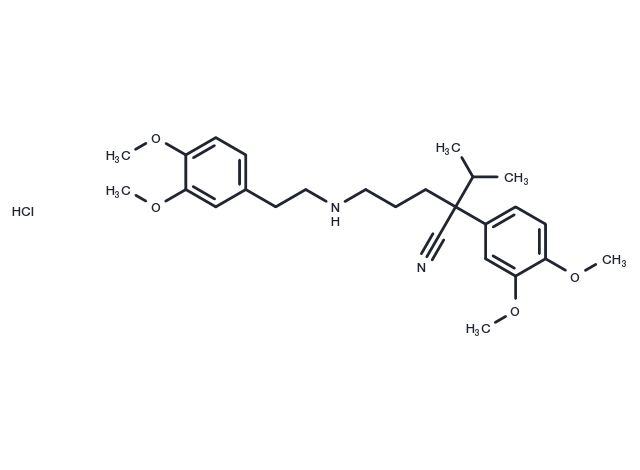Powder: -20°C for 3 years | In solvent: -80°C for 1 year


Norverapamil hydrochloride (D591 hydrochloride) ((±)-Norverapamil hydrochloride) is an N-demethylated metabolite of Verapamil and it is an L-type calcium channel blocker and a P-glycoprotein (P-gp) function inhibitor.

| Pack Size | Availability | Price/USD | Quantity |
|---|---|---|---|
| 1 mg | In stock | $ 53.00 | |
| 2 mg | In stock | $ 77.00 | |
| 5 mg | In stock | $ 117.00 | |
| 10 mg | In stock | $ 197.00 | |
| 25 mg | In stock | $ 451.00 | |
| 50 mg | In stock | $ 663.00 | |
| 100 mg | In stock | $ 937.00 | |
| 1 mL * 10 mM (in DMSO) | In stock | $ 123.00 |


| Description | Norverapamil hydrochloride (D591 hydrochloride) ((±)-Norverapamil hydrochloride) is an N-demethylated metabolite of Verapamil and it is an L-type calcium channel blocker and a P-glycoprotein (P-gp) function inhibitor. |
| In vitro | Norverapamil inhibits macrophage-induced tolerance and attains serum levels comparable to verapamil. Both verapamil and its primary metabolite, Norverapamil, are identified as mechanism-based inhibitors and substrates of CYP3A, exhibiting non-linear pharmacokinetics clinically. Furthermore, ((±)-Norverapamil hydrochloride) proves as effective as verapamil in inhibiting tolerance and killing intracellular M. tuberculosis in monotherapy, matching its efficacy against isoniazid and rifampicin tolerance [1][3]. |
| In vivo | Norverapamil hydrochloride (9 mg/kg; p.o.) has a terminal half-life, AUC and Cmax values of 9.4 hours, 260 ng?h/ml, and 41.6 ng/mL, respectively[4]. |
| Synonyms | (±)-Norverapamil hydrochloride, D591 hydrochloride |
| Molecular Weight | 477.04 |
| Formula | C26H37ClN2O4 |
| CAS No. | 67812-42-4 |
Powder: -20°C for 3 years | In solvent: -80°C for 1 year
H2O: 50 mg/mL (104.81 mM)
DMSO: 31 mg/mL (64.98 mM)
You can also refer to dose conversion for different animals. More
bottom
Please see Inhibitor Handling Instructions for more frequently ask questions. Topics include: how to prepare stock solutions, how to store products, and cautions on cell-based assays & animal experiments, etc.
Norverapamil hydrochloride 67812-42-4 Membrane transporter/Ion channel Metabolism Neuroscience Drug Metabolite P-gp Calcium Channel MDR1 CD243 Inhibitor mycobacterial Norverapamil M. tuberculosis Multidrug resistance protein 1 D 591 Hydrochloride Ca2+ channels metabolite (±)-Norverapamil D-591 Hydrochloride efflux D591 Hydrochloride Ca channels P-glycoprotein inhibit Norverapamil Hydrochloride ABCB1 Cluster of differentiation 243 (±)-Norverapamil hydrochloride D 591 pumps D591 hydrochloride D-591 D591 Pgp inhibitor
